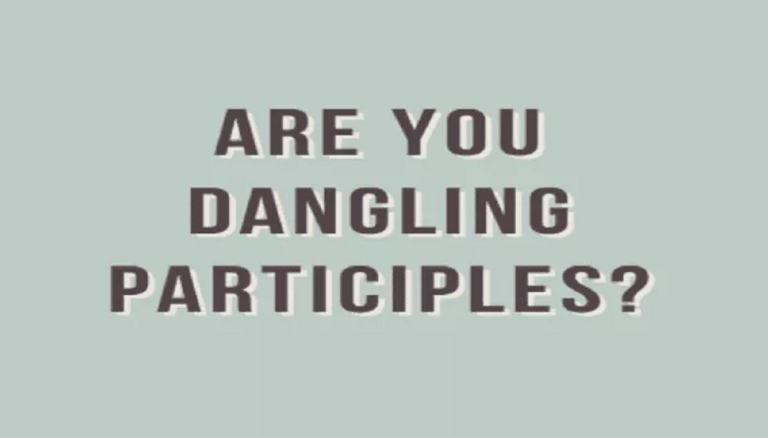What Is a Participle?
Before we talk about what it means to dangle a participle, we have to answer the question What is a participle?
It’s a tough question because participles have a few different jobs. Today, we’re only going to talk about their job that makes them look like adjectives. They tell you more about the noun that follows.
Participles can be in the present tense or the past tense, and the present participle always ends with “ing.” For example, “dream” is a verb, and “dreaming” is its present participle. “Speed” is a verb, and “speeding” is its present participle. To use the verb, you could say, “He will speed on the freeway.” “Speed” is an action, a verb.
To use “speeding” as an adjective-like participle, you could say, “Follow that speeding car.” “Speeding” acts something like an adjective modifying the noun “car.” It tells you what the car is doing—what kind of car it is—a speeding car.
Here’s another example: “hike” is a verb, and “hiking” is the present participle. To use the verb, you could say “Let’s hike the trail.” To use the participle, you could say, “Wait for the hiking campers to get back.” “Hiking,” the participle, tells you what the campers are doing—what kind of campers they are—hiking campers.
Participles have another role too: They help form the perfect and progressive verb tenses, but we won’t talk about those here. (See this article for information on verb tenses.)
What Is a Participial Phrase?
So now I trust that you understand how to use verbs and their participles, but to understand dangling participles, we need to talk about participial phrases. These are just phrases that contain a participle and modify the subject of the sentence.
They can include words besides the participle, such as prepositions, pronouns, and nouns, but for now, we’ll just focus on the idea that they contain a participle like “speeding” or “hiking.” The way they modify the subject isn’t as straightforward as a single adjective modifying a single noun, but the participial phrase is still modifying a noun or noun phrase—the subject.
Here are some examples to help make it more clear:
Floating in the pool, I marveled at the clouds.
“Floating in the pool” is the participial phrase that modifies the subject, “I.” “Floating” is the participle in the phrase “floating in the pool.” It describes what I am doing.
Here’s another one:
Biting his victim, the vampire felt a momentary thrill.
“Biting his victim” is the participial phrase that modifies the subject, “the vampire.” “Biting” is the participle in the phrase “biting his victim.” It describes what the vampire is doing.
And one last example:
Beating you over the head with examples, I hope to make you understand participial phrases.
“Beating you over the head with examples” is the participial phrase modifying the subject, “I.” “Beating” is the participle in the phrase “beating you over the head with examples.” It describes what I am doing.
A dangling participle modifies an unintended subject.
In all three of those examples, the subject that was being modified by the participial phrase came right after the phrase. It was sticking close to the modifier so you couldn’t miss it. The participial phrase doesn’t have to be at the beginning of a sentence, but that is the place where it’s most likely to dangle, so we’ll stick with that format today.
Dangling Participles
Now we’re ready to learn about dangling participles.
When you dangle a participle, it means your participial phrase is hanging there in your sentence with no proper subject in sight. They hate that as much as you hate it when a friend stands you up for lunch.
Here’s an example:
Hiking the trail, the birds chirped loudly.
The birds are the only subject in the sentence, and they directly follow the participial phrase. The participial phrase has to grab on to something, so it grabs the only subject—the birds. So what that sentence says is that the birds were hiking the trail, and that’s probably not what I mean. There was probably somebody hiking the trail and hearing the birds chirping loudly.
We can fix it by adding the proper subject right after the participial phrase:
Hiking the trail, Squiggly and Aardvark heard birds chirping loudly.
Now “hiking the trail” modifies “Squiggly and Aardvark” as it should because they are the subject. They are the ones hiking the trail.
Here’s another dangling modifier:
Wishing I could sing, the high notes seemed to taunt me.
Did you see the problem? The high notes are the only subject in the sentence, so the participial phrase “wishing I could sing” attaches to that noun because it doesn’t want to dangle. That makes a sentence that says the high notes wish I could sing. If they were capable of wishing, they might wish I could sing, but what I’m really trying to say in that sentence is
Wishing I could sing, I feel taunted by the high notes.
In that sentence, “wishing I could sing” correctly modifies the subject “I,” and it makes a lot more sense than imagining cringing high notes.
Summary
A dangling participle modifies the wrong noun. Usually you’ve left the subject implied and are taking for granted that your reader will know what you mean, which is generally not a good writing strategy. You fix a dangling modifier by putting the proper subject in the sentence, usually right after the participle or participial phrase.
Mignon Fogarty is Grammar Girl and the founder of Quick and Dirty Tips. Check out her New York Times best-seller, “Grammar Girl’s Quick and Dirty Tips for Better Writing.”




